Kingdom Of The Vandals: A People In Search Of A Home
David Tee - AncientPages.com - The name may bring fear to many, as this ancient society is forever linked with those who cause destruction to property - vandals, and vandalism. Yet they may not have been as fierce or destructive as their modern namesakes.
Left: Genseric, leader of the Vandlas in North Africa. Credit: Janboruta, Public Domain - Right:Reconstruction of an Iron Age warrior's garments representing a Vandalic man, with his hair in a "Suebian knot" on display at Archaeological Museum of Kraków, Poland. Credit: Public Domain, CC BY-SA 3.0
Trying to find the origin of the original Vandal people is difficult. Historical records state the tribe appeared first inhabiting present-day southern Poland. Some historians have found the name in central Sweden, in the parish of Vendel. Plus, the name has cropped up in Denmark and Norway with possible ties to a Norwegian royal family.
Wherever they came from, it seems that the people were in search of a home.
First Roman Contact With The Vandals
The Vandals seem to have been in contact with Rome early on and when the Roman Empire was at its height. Cassius wrote that the Vandals were led by Raus and Raptus and after a battle they made peace in exchange for some land.
The Sack of Rome, Karl Briullov, 1833–1836. Credit: Public Domain
For some reason, and it could possibly be that the Vandals had no permanent home, they made little impact on the archaeological record. They also appeared very briefly in historical records.
But they were able to defeat the Romans in Spain in the early 5th century and were even allies of Rome at one time as Stilicho, a Roman general, who was of Vandal origin. The 5th century was one of struggle for the Vandals as they fought the Franks, the Huns, The Romans and the Visigoths.
The Vandals In Spain And Beyond
The battle victory against the Romans in Spain was due to two factors. First, the Visigoths decided to not honor their allied agreement with the Romans. Their departure left the Romans militarily weak.
Then, second, The Roman general Castinus changed strategies and decided to attack the Vandals instead of starving them into surrender. After the defeat of the Romans, the Vandals were able to broaden their conquest of Spain and captured the city of Seville after two attempts.
For some reason, Spain was not to be the Vandals' home. Their new leader, Genseric, decided that North Africa was the place for the Vandals to migrate to and conquer. The exact number of Vandals who went to North Africa is unknown, and some historians discount the 80,000 number.
The Vandals In North Africa
The reason that the Vandals went to North Africa is unclear as well. Some historians claim that they went at the invitation of Bonifacius, while others claim it was done in search of safety.
Migrations of the Vandals from Scandinavia through Dacia, Gaul, Iberia, and into North Africa. Grey: Roman Empire. Credit: Public Domain
Whatever the reason, the Vandals decided that Hippo would be their first capital. They laid siege to that city even though St. Augustine was living there at the time. It took the Vandals 14 months to bring the city to its knees.
The Vandals in 435 AD, finally made a treaty with the Romans and the latter gave them large amounts of territory as their own. But for Genseric, the territory was not enough, and he broke the treaty in 49 AD, by attacking and conquering Carthage.
Carthage became the new Vandal capital, and from their Genseric, who ruled for 50 years, conquered Sicily, Malta, Sardinia, Corsica, and other islands. From their wandering beginnings, the Vandals may have finally found their home.
The Vandals And Rome Were Not Finished
Genseric used his new home to raid and conquer other parts of the Roman empire. Unfortunately, the Romans were battling the Gauls at the time and Attila the Hun, so they could not address their empire's reduction at the Vandals' hands.
The Romans tried to regain their territory, but that peace effort was undone by Valentinian III's assassination. Genseric did not like what took place and attacked Rome. It is said that Pope Leo I had Genseric agree not to kill or burn but simply plunder.
This was done, and it is said that he took the treasures from the Temple of Jerusalem back to Carthage with him.
The Vandal End
After Genseric died, a few weak rulers came to the Vandal throne, but those rules were unstable due to infighting and other intrigues. This situation left the Vandals weak and ripe for conquest.
It was the Byzantines who finally put an end to the Vandal Empire and civilization.
Updated on April 18, 2024
Written by – David Tee AncientPages.com
Copyright © AncientPages.com All rights reserved. This material may not be published, broadcast, rewritten or redistributed in whole or part without the express written permission of AncientPages.com
Expand for referencesMore From Ancient Pages
-
 Unique 2,000-Year-Old Decorated Roman Sandal Lost By Well-Cleaner Found In Spain
Archaeology | Oct 19, 2023
Unique 2,000-Year-Old Decorated Roman Sandal Lost By Well-Cleaner Found In Spain
Archaeology | Oct 19, 2023 -
 Complex Of Goguryeo Tombs: Beautiful Ancient Wall Paintings Displaying History And Mythology Of North Korea
Civilizations | Oct 19, 2018
Complex Of Goguryeo Tombs: Beautiful Ancient Wall Paintings Displaying History And Mythology Of North Korea
Civilizations | Oct 19, 2018 -
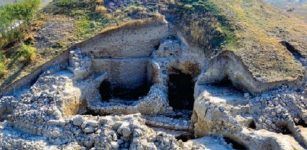 6,300 Years Old Golden Artifact Unearthed At Solnitsata ‘The Salt Pit’ Prehistoric Settlement
Archaeology | Nov 23, 2015
6,300 Years Old Golden Artifact Unearthed At Solnitsata ‘The Salt Pit’ Prehistoric Settlement
Archaeology | Nov 23, 2015 -
 Megalithic Giant Tripolye ‘Mega-Structures’ In Large Settlements That Collapsed Around 3650 BC
Archaeology | Oct 1, 2019
Megalithic Giant Tripolye ‘Mega-Structures’ In Large Settlements That Collapsed Around 3650 BC
Archaeology | Oct 1, 2019 -
 Number 13: Coincidence Or Bad Luck – Are We Still Superstitious?
Featured Stories | Dec 9, 2020
Number 13: Coincidence Or Bad Luck – Are We Still Superstitious?
Featured Stories | Dec 9, 2020 -
 Secret Ancient Knowledge Of Portals Leading To Unknown Realms -The Arrival And Departure – Part 1
Ancient Mysteries | Dec 1, 2021
Secret Ancient Knowledge Of Portals Leading To Unknown Realms -The Arrival And Departure – Part 1
Ancient Mysteries | Dec 1, 2021 -
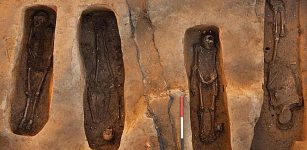 Jamestown: Unearthed graves with four bodies and a small sealed silver box
News | Aug 28, 2015
Jamestown: Unearthed graves with four bodies and a small sealed silver box
News | Aug 28, 2015 -
 On This Day In History: Emperor Romulus Augustus Deposed – On September 4, 476
News | Sep 4, 2016
On This Day In History: Emperor Romulus Augustus Deposed – On September 4, 476
News | Sep 4, 2016 -
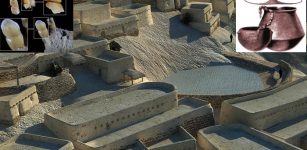 4,000 Years Ago Women Of El Argar Used Their Teeth As Tools
Archaeology | Nov 10, 2020
4,000 Years Ago Women Of El Argar Used Their Teeth As Tools
Archaeology | Nov 10, 2020 -
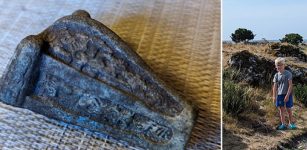 8-Year-Old Boy Finds Unusual Viking Age Artifact On Gotland Island, Sweden
Archaeology | Sep 18, 2023
8-Year-Old Boy Finds Unusual Viking Age Artifact On Gotland Island, Sweden
Archaeology | Sep 18, 2023 -
 X-Ray Reveal Ghostly Portrait Of Mary Queen Of Scots Hidden Underneath 16th Century Painting
Archaeology | Nov 3, 2017
X-Ray Reveal Ghostly Portrait Of Mary Queen Of Scots Hidden Underneath 16th Century Painting
Archaeology | Nov 3, 2017 -
 Elusive Non-Binary Gender In Prehistoric Europe – A Forgotten Minority
Archaeology | May 26, 2023
Elusive Non-Binary Gender In Prehistoric Europe – A Forgotten Minority
Archaeology | May 26, 2023 -
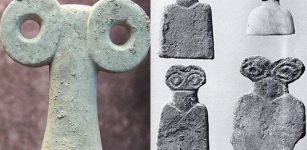 Remarkable Ancient Statues From The Eye Temple – Unique Legacy From Tell Brak, Syria
Artifacts | Jul 20, 2018
Remarkable Ancient Statues From The Eye Temple – Unique Legacy From Tell Brak, Syria
Artifacts | Jul 20, 2018 -
 Cappadocia And Huge Unique Selime Cathedral
Featured Stories | Mar 19, 2019
Cappadocia And Huge Unique Selime Cathedral
Featured Stories | Mar 19, 2019 -
 Bellerophon: Great Hero Of Homer’s Iliad Who Was Punished By Gods For His Pride And Arrogance
Featured Stories | Jul 13, 2021
Bellerophon: Great Hero Of Homer’s Iliad Who Was Punished By Gods For His Pride And Arrogance
Featured Stories | Jul 13, 2021 -
 How Did 20th-Century Philosophers Explain Ghosts And Other Spooky Subjects?
Featured Stories | Nov 8, 2024
How Did 20th-Century Philosophers Explain Ghosts And Other Spooky Subjects?
Featured Stories | Nov 8, 2024 -
 Aztec Skull Whistles: Unique, Terrifying Instruments With Scary And Scream-Like Nature That Paralized Human’s Mind
Archaeology | Nov 18, 2024
Aztec Skull Whistles: Unique, Terrifying Instruments With Scary And Scream-Like Nature That Paralized Human’s Mind
Archaeology | Nov 18, 2024 -
 Askeladden – Little Trickster That Succeeds Where All Others Fail
Featured Stories | Mar 23, 2018
Askeladden – Little Trickster That Succeeds Where All Others Fail
Featured Stories | Mar 23, 2018 -
 Mystery Of Doppelgangers And Spirit Doubles – From Ancient To Modern Times
Featured Stories | Sep 16, 2014
Mystery Of Doppelgangers And Spirit Doubles – From Ancient To Modern Times
Featured Stories | Sep 16, 2014 -
 Mystery Of The Maya Blue Pigment And Its Unusual Chemical Composition
Ancient History Facts | Mar 23, 2016
Mystery Of The Maya Blue Pigment And Its Unusual Chemical Composition
Ancient History Facts | Mar 23, 2016



